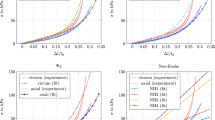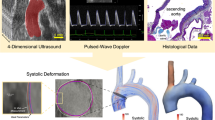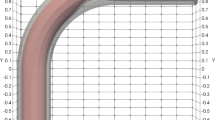Abstract
The objective of this work is to address the formulation of an adequate model of the external tissue environment when studying a portion of the arterial tree with fluid–structure interaction. Whereas much work has already been accomplished concerning flow and pressure boundary conditions associated with truncations in the fluid domain, very few studies take into account the tissues surrounding the region of interest to derive adequate boundary conditions for the solid domain. In this paper, we propose to model the effect of external tissues by introducing viscoelastic support conditions along the artery wall, with two—possibly distributed—parameters that can be adjusted to mimic the response of various physiological tissues. In order to illustrate the versatility and effectiveness of our approach, we apply this strategy to perform patient-specific modeling of thoracic aortae based on clinical data, in two different cases and using a distinct fluid–structure interaction methodology for each, namely an Arbitrary Lagrangian–Eulerian (ALE) approach with prescribed inlet motion in the first case and the coupled momentum method in the second case. In both cases, the resulting simulations are quantitatively assessed by detailed comparisons with dynamic image sequences, and the model results are shown to be in very good adequacy with the data.
Similar content being viewed by others
References
Alastrué V, Garcia A, Peña E, Rodríguez JF, Martínez MA, Doblaré M (2010) Numerical framework for patient-specific computational modelling of vascular tissue. Int J Numer Methods Biomed Eng 26(1): 35–51
Bertoglio C, Fernández M, Gerbeau J-F, Moireau P (2009) Filtering-based data assimilation in fluid-structure interaction: towards personalization of vascular models. In: Nithiarasu P, Löhner R (eds) 1st International conference on mathematical and computational biomedical engineering—CMBE
Blanco PJ, Feijóo RA, Urquiza SA (2007) A unified variational approach for coupling 3D-1D models and its blood flow applications. Comput Methods Appl Mech Eng 196(41–44): 4391–4410
Blanco PJ, Pivello MR, Urquiza SA, Feijóo RA (2009) On the potentialities of 3D–1D coupled models in hemodynamics simulations. J Biomech 42(7): 919–930
Chabiniok R, Chapelle D, Lesault PF, Rahmouni A, Deux JF (2009) Validation of a biomechanical heart model using animal data with acute myocardial infarction. In: CI2BM09–MICCAI workshop on cardiovascular interventional imaging and biophysical modelling, London, UK
Chen CH, Nevo E, Fetics B, Pak PH, Yin FC, Maughan WL, Kass DA (1997) Estimation of central aortic pressure waveform by mathematical transformation of radial tonometry pressure. validation of generalized transfer function. Circulation 95(7): 1827–1836
Ciarlet PG (1988) Mathematical elasticity. Vol. I, volume 20 of Studies in Mathematics and its Applications. North-Holland Publishing Co, Amsterdam
Fernández MA, Gerbeau J-F (2009) Fluid structure interaction problems in haemodynamics, chap 9. In: Formaggia L, Quarteroni A, Veneziani A (eds) Mathematical Modelling of the Cardiovascular System. Springer, Berlin
Fernández MA, Gerbeau J-F, Grandmont C (2006) A projection algorithm for fluid-structure interaction problems with strong added-mass effect. C R Acad Sci Paris Math 342
Fernández MA, Gerbeau J-F, Grandmont C (2007) A projection semiimplicit scheme for the coupling of an elastic structure with an incompressible fluid. Int J Numer Methods Eng 69(4):794–821
Figueroa CA, Vignon-Clementel IE, Jansen KE, Hughes TJR, Taylor CA (2006) A coupled momentum method for modeling blood flow in three-dimensional deformable arteries. Comput Methods Appl Mech Eng 195(41–43): 5685–5706
Formaggia L, Gerbeau J-F, Nobile F, Quarteroni A (2001) On the coupling of 3D and 1D Navier-Stokes equations for flow problems in compliant vessels. Comput Methods Appl Mech Eng 191(6–7): 561–582
Formaggia L, Moura A, Nobile F (2007) On the stability of the coupling of 3D and 1D fluid-structure interaction models for blood flow simulations. M2AN Math Model Numer Anal 41(4): 743–769
Fung Y (1993) Biomechanics: mechanical properties of living tissues, 2nd edn. Springer, Berlin
Gee M, Förster C, Wall W (2010) A computational strategy for prestressing patient-specific biomechanical problems under finite deformation. Int J Numer Methods Biomed Eng 26(1): 52–72
Hauret P, Le Tallec P (2006) Energy-controlling time integration methods for nonlinear elastodynamics and low-velocity impact. Comput Methods Appl Mech Eng 195(37–40): 4890–4916
Holzapfel GA (2006) Determination of material models for arterial walls from uniaxial extension tests and histological structure. J Theor Biol 238(2): 290–302
Humphrey JD (2003) Continuum biomechanics of soft biological tissues. Proc R Soc Lond A 459: 3–46
Kerckhoffs RCP, Neal ML, Gu Q, Bassingthwaighte JB, Omens JM, Mcculloch AD (2007) Coupling of a 3D finite element model of cardiac ventricular mechanics to lumped systems models of the systemic and pulmonic circulation. Ann Biomed Eng 35(1): 1–18
Kim HJ, Figueroa CA, Hughes TJR, Jansen KE, Taylor CA (2009) Augmented lagrangian method for constraining the shape of velocity profiles at outlet boundaries for three-dimensional finite element simulations of blood flow. Comput Methods Appl Mech Eng
Kim HJ, Vignon-Clementel IE, Figueroa CA, LaDisa JF, Jansen KE, Feinstein JA, Taylor CA (2009) On coupling a lumped parameter heart model and a three-dimensional finite element aorta model. Ann Biomed Eng 37(11): 2153–2169
Le Tallec P (1994) Numerical methods for nonlinear three-dimensional elasticity. In: Handbook of numerical analysis, vol III. North-Holland, pp 465–622
Les AS, Shadden SC, Figueroa CA, Park JM, Tedesco MM, Herfkens RJ, Dalman RL, Taylor CA (2010) Quantification of hemodynamics in abdominal aortic aneurysms during rest and exercise using magnetic resonance imaging and computational fluid dynamics. Ann Biomed Eng 38(4): 1288–1313
Moireau P, Chapelle D (2010) Reduced-order unscented Kalman filtering with application to parameter identification in large-dimensional systems. Cont Optim Calc Variat [Epub ahead of print]
Moireau P, Chapelle D, Le Tallec P (2008) Joint state and parameter estimation for distributed mechanical systems. Comput Methods Appl Mech Eng 197: 659–677
Moireau P, Chapelle D, Le Tallec P (2009) Filtering for distributed mechanical systems using position measurements: Perspectives in medical imaging. Inverse Probl 25(3): 035010 (25pp)
Papadakis G (2009) Coupling 3D and 1D fluid-structure-interaction models for wave propagation in flexible vessels using a finite volume pressure-correction scheme. Commun Numer Methods Eng 25(5): 533–551
Sainte-Marie J, Chapelle D, Cimrman R, Sorine M (2006) Modeling and estimation of the cardiac electromechanical activity. Comput Struct 84: 1743–1759
Spilker RL, Taylor CA (2010) Tuning multidomain hemodynamic simulations to match physiological measurements. Ann Biomed Eng 38(8): 2635–2648
Taylor CA, Figueroa CA (2009) Patient-specific modeling of cardiovascular mechanics. Annual review of biomedical engineering, vol 11. Annual reviews, pp 109–134
Taylor CA, Hughes TJR, Zarins CK (1998) Finite element modeling of blood flow in arteries. Comput Methods Appl Mech Eng 158: 155–196
Vignon-Clementel IE, Figueroa CA, Jansen KE, Taylor CA (2006) Outflow boundary conditions for three-dimensional finite element modeling of blood flow and pressure in arteries. Comput Methods Appl Mech Eng 195(29–32): 3776–3796
Vignon-Clementel IE, Figueroa CA, Jansen KE, Taylor CA (2010) Outflow boundary conditions for 3D simulations of non-periodic blood flow and pressure fields in deformable arteries. Comput Methods Biomech Biomed Eng
Weiss B, Spahn DR, Rahmig H, Rohling R, Pasch T (1996) Radial artery tonometry: moderately accurate but unpredictable technique of continuous non-invasive arterial pressure measurement. Br J Anaesth 76(3): 405–411
Whiting C, Jansen K (2001) A stabilized finite element method for the incompressible Navier-Stokes equations using a hierarchical basis. Int J Numer Methods Fluids 35: 93–116
Xiong G, Figueroa CA, Xiao N, Taylor CA (2010) Simulation of blood flow in deformable vessels using subject-specific geometry and assigned variable mechanical wall properties. Int J Numer Methods Biomed Eng (Published online)
Yushkevich PA, Piven J, Hazlett HC, Smith RG, Ho S, Gee JC, Gerig G (2006) User-guided 3d active contour segmentation of anatomical structures: Significantly improved efficiency and reliability. Neuroimage 31(3): 1116–1128
Author information
Authors and Affiliations
Corresponding author
Rights and permissions
About this article
Cite this article
Moireau, P., Xiao, N., Astorino, M. et al. External tissue support and fluid–structure simulation in blood flows. Biomech Model Mechanobiol 11, 1–18 (2012). https://doi.org/10.1007/s10237-011-0289-z
Received:
Accepted:
Published:
Issue Date:
DOI: https://doi.org/10.1007/s10237-011-0289-z




